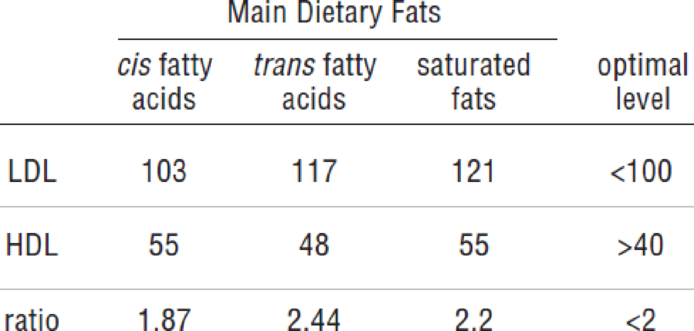
Concept explainers
Effects of Dietary Fats on Lipoprotein Levels
Cholesterol that is made by the liver or that enters the body from food does not dissolve in blood, so it is carried through the bloodstream by lipoproteins. Low-density lipoprotein (LDL) carries cholesterol to body tissues such as artery walls, where it can form deposits associated with cardiovascular disease. Thus, LDL is often called “bad” cholesterol. Highdensity lipoprotein (HDL) carries cholesterol away from tissues to the liver for disposal, so HDL is often called “good” cholesterol. In 1990, Ronald Mensink and Martijn Katan published a study that tested the effects of different dietary fats on blood lipoprotein levels. Their results are shown in Figure 2.23.

In which group was the level of LDL (“bad” cholesterol) highest?
Want to see the full answer?
Check out a sample textbook solution
Chapter 2 Solutions
Biology Today and Tomorrow without Physiology (MindTap Course List)
- Effects of Dietary Fats on Lipoprotein Levels Cholesterol that is made by the liver or that enters the body from food does not dissolve in blood, so it is carried through the bloodstream by lipoproteins. Low-density lipoprotein (LDL) carries cholesterol to body tissues such as artery walls, where it can form deposits associated with cardiovascular disease. Thus, LDL is often called bad cholesterol. Highdensity lipoprotein (HDL) carries cholesterol away from tissues to the liver for disposal, so HDL is often called good cholesterol. In 1990, Ronald Mensink and Martijn Katan published a study that tested the effects of different dietary fats on blood lipoprotein levels. Their results are shown in Figure 2.23. Figure 2.23 Effect of diet on lipoprotein levels. Researchers placed 59 men and women on a diet in which 10 percent of their daily energy intake consisted of cis fatty acids, trans fatty acids, or saturated fats. Blood LDL and HDL levels were measured after three weeks on the diet; averaged results are shown in mg/dL (milligrams per deciliter of blood). All subjects were tested on each of the diets. The ratio of LDL to HDL is also shown. Source, Mensink RP, Katan MB, Effect of dietary trans fatty acids on high-density and low-density lipoprotein cholesterol levels in healthy subjects. NEJM 323(7):43945. An elevated risk of heart disease has been correlated with increasing LDL-to-HDL ratios. Rank the three diets according to their predicted effect on cardiovascular health.arrow_forwardEffects of Dietary Fats on Lipoprotein Levels Cholesterol that is made by the liver or that enters the body from food does not dissolve in blood, so it is carried through the bloodstream by lipoproteins. Low-density lipoprotein (LDL) carries cholesterol to body tissues such as artery walls, where it can form deposits associated with cardiovascular disease. Thus, LDL is often called bad cholesterol. Highdensity lipoprotein (HDL) carries cholesterol away from tissues to the liver for disposal, so HDL is often called good cholesterol. In 1990, Ronald Mensink and Martijn Katan published a study that tested the effects of different dietary fats on blood lipoprotein levels. Their results are shown in Figure 2.23. In which group was the level of HDL (good cholesterol) lowest?arrow_forwardCurrent dietary recommendations to reduce the risk of coronary heart disease include all of the following EXCEPT O Eliminate all dietary cholesterol from your diet, such as that found in egg yolk, because it is the main cause of heart disease. O Consume more monounsaturated and polyunsaturated fats such as those found in olive oil, fish, nuts, and avocados instead of saturated fats found in red meats. O Increase consumption of oats, legumes, and soy products that may help lower blood cholesterol levels. O Try to eliminate trans-fats from your diet completely.arrow_forward
- Which of the following statement/s is/are true? 1. Oil is a mixture of tricylgylcerols that is solid because it contains high proportions of unsaturated fatty acids. 2. Oil is a mixture of tricylglycerol that is liquid because it contains a high proportions of unsaturated fatty acids. 3. Fat is a mixture of triacygycerols that is solid because it contains a high proportions of saturated fatty acids. 4. Fat is a mixture of triacyglycerols that is liquid because it contains a high proportions of saturated fatty acids.arrow_forwardFoods rich in unsaturated fatty acids tend to be liquid at room temperature. True Falsearrow_forwardLipoproteins are relatively large, combined clumps of both protein and lipid molecules that circulate in the blood of mammals. They come in two forms, called HDL and LDL, and they act like suitcases to move cholesterol, fatty acid remnants, triglycerides, and phospholipids from one place to another through the bloodstream. (LDL recirculates lipids throughout the body, while HDL takes lipids to the liver to excrete them in feces.) Given that lipids are hydrophobic and proteins can be hydrophilic, which of the following statements is correct? (a) The lipid portion of LDL does not dissolve in the bloodstream, while the lipid portion of HDL does. (b) The protein portions of both LDL and HDL can dissolve or interact with the water molecules in the bloodstream. (c) Neither the protein nor the lipid portions of LDL molecules can interact with water molecules in the bloodstream. (d) Both the protein and the lipid portions of HDL molecules can interact with water molecules in the bloodstream.…arrow_forward
- In dietary context, what is the difference between good and bad cholesterol? In dietary context, how do HDL and LDL differ in function?arrow_forwardWhen natural monounsaturated fats generally undergo the chemical process of partial hydrogenation, their fatty acid chains are converted into the following two forms: trans and saturated. O True Falsearrow_forwardA bowl of raisin bran contains the following amounts of carbohydrate: Starch: 13 grams Fiber: 4 grams Sugar: 11 grams Total: 28 grams How many carbohydrate calories will it provide to your body after digestion?arrow_forward
- The total carbohydrate intake of sucrose was 50 moles. These carbohydrates are absorbed such that glucose is only 90% absorbed while fructose is absorbed completely. If the absorbed monosaccharides in become fats, how many moles palmitate will be formed from these?arrow_forwardWhile not a lipid, cholesterol is often found associated with membranes. Explain how a cholesterol molecule is able to be held in place, and which parts of the cholesterol associate with which parts of the lipds. Animals like caribou (a.k.a. reindeer) that live in cold arctic regions such as the north pole often have more cholesterol in their legs than the rest of their bodies. Suggest a reason this may occur (cholesterol does not help with flight).arrow_forwardSome foods naturally have high levels of the free amino acid. For example, parmesan cheese (1689 mg), tomato (246 mg), scallop (159 mg), corn (106 g), and shrimp (43 mg). Wheat protein (gluten) is typically comprised of 30-35% of this amino acid. People with celiac disease cannot metabolize gluten, but have no trouble with foods high in the natural amino acid or MSG. Why is this?arrow_forward
 Biology Today and Tomorrow without Physiology (Mi...BiologyISBN:9781305117396Author:Cecie Starr, Christine Evers, Lisa StarrPublisher:Cengage Learning
Biology Today and Tomorrow without Physiology (Mi...BiologyISBN:9781305117396Author:Cecie Starr, Christine Evers, Lisa StarrPublisher:Cengage Learning Biology: The Dynamic Science (MindTap Course List)BiologyISBN:9781305389892Author:Peter J. Russell, Paul E. Hertz, Beverly McMillanPublisher:Cengage Learning
Biology: The Dynamic Science (MindTap Course List)BiologyISBN:9781305389892Author:Peter J. Russell, Paul E. Hertz, Beverly McMillanPublisher:Cengage Learning



